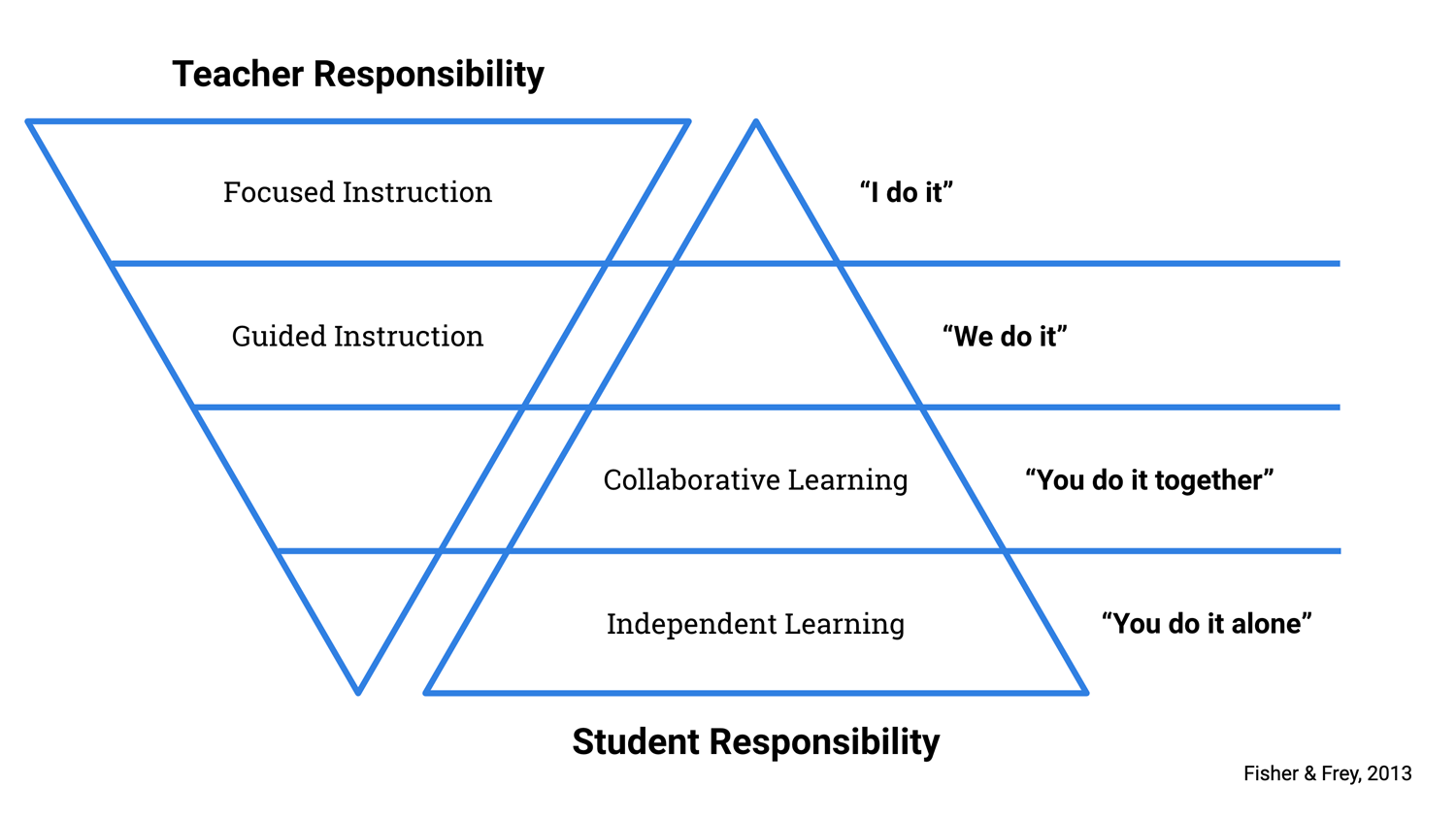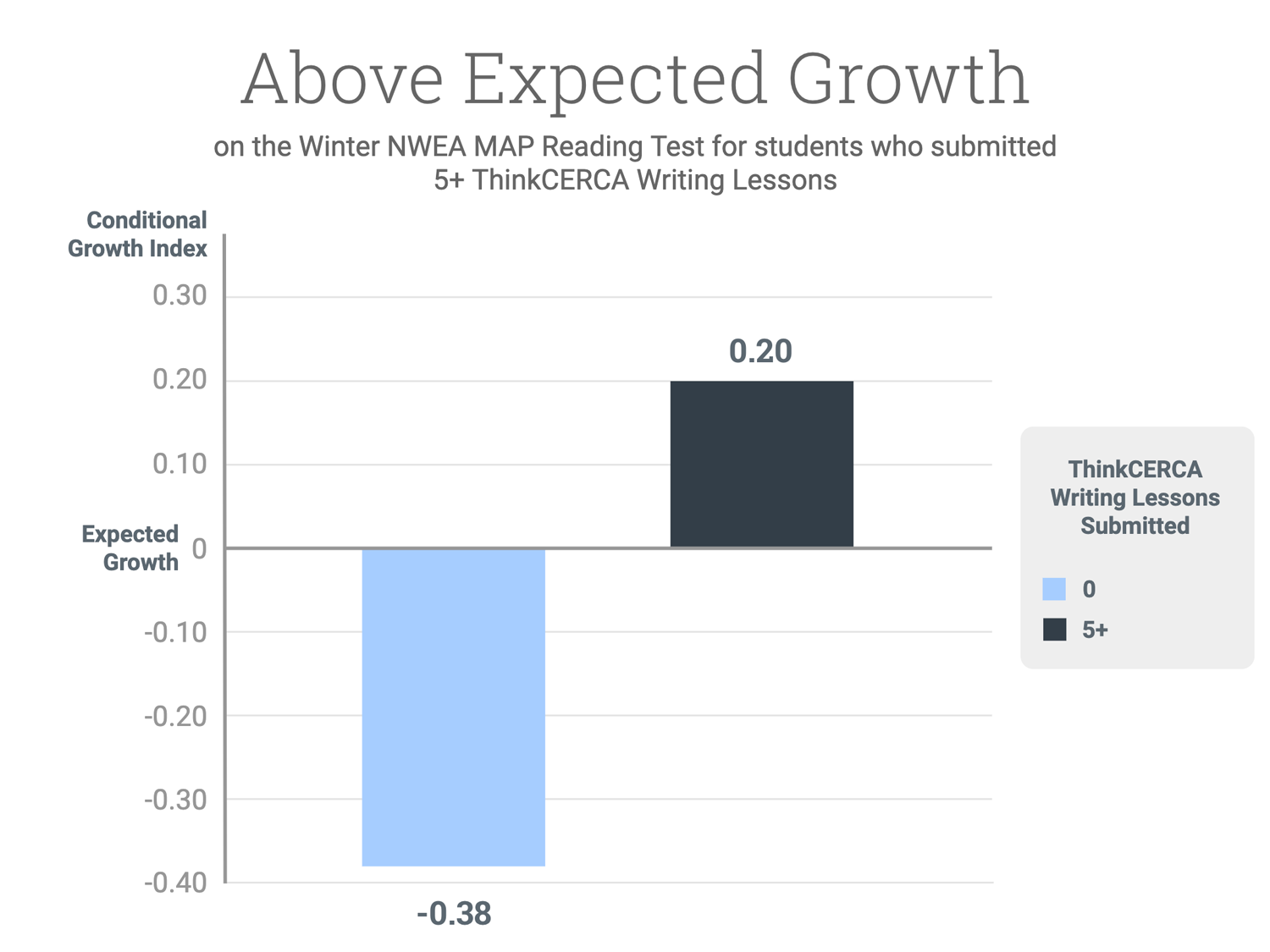Youngstown City Schools Case Study
Significant Reading Growth by Mid-Year Assessments
In a high-poverty, high-mobility Ohio school district, consistent writing instruction made all the difference.
Key Takeaways
On the 2019 mid-year NWEA MAP assessment:
-
Students who submitted five or more ThinkCERCA Writing Lessons demonstrated more than twice the growth in RIT (reading growth) scores than students who did not submit a Writing Lesson.
- Students who submitted five or more Writing Lessons achieved their normative growth targets at a rate slightly higher than expected. Meanwhile, students who submitted zero Writing Lessons did not achieve their expected growth targets.
Download the Case Study
The Challenge
Like districts everywhere, Youngstown City School District in Ohio is committed to delivering quality instruction to all its students. Unlike most districts across the state, however, Youngstown City Schools also contends with a host of challenges, from increased poverty and student mobility to high teacher turnover.
The most recent Ohio Department of Education data indicates that, of more than 600 school districts in Ohio, Youngstown City School District has the second-lowest median income. The Ohio Department of Education classifies eight school districts as “Urban - Very High Student Poverty & Very Large Student Population.” Youngstown City is one of these districts.
Youngstown City School District also has a high mobility of students, with 20.5 percent of students changing schools in the 2017-18 school year. According to Tiffaney Trella, the Technology Integration Supervisor at Youngstown, each year about 100 new teachers join the district.
With a changing staff and student population, Youngstown needed a way to create consistency in instruction from year to year. The district prioritized literacy across the curriculum and decided to invest in technology that could help teachers deliver that instruction. In addition, district leaders made the commitment to only partner with ed-tech companies that demonstrated proven impact.
Youngstown’s search led them to a partnership with ThinkCERCA, informed by third-party studies and district results showing the positive effect that writing with ThinkCERCA has had on student outcomes.
The Implementation
Professional Development
In the 2017-18 school year, Youngstown City Schools began implementing ThinkCERCA in grades 4-12 in English language arts, science, and social studies. Usage accelerated in the 2018-19 school year, with commitment from district leadership to continuous and personalized professional development in literacy and ThinkCERCA best practices.
As part of the professional learning initiative, a teacher from each Youngstown school attended CERCA Institute, a two-day event designed to strengthen educators’ knowledge of literacy, critical thinking, and ThinkCERCA. These teachers were able to start the 2018-19 school year with the skills to support fellow teachers in using ThinkCERCA. When the school year began, all teachers were encouraged to share their literacy knowledge with each other.
“Even across buildings in our districts, teachers will go to another building and watch a teacher teaching a ThinkCERCA lesson and then take it back to their classroom,” Trella said.
Additionally, Youngstown’s dedicated ThinkCERCA representative, Steve Glaeser, visited Youngstown schools throughout the year to train teachers by grade and by subject in literacy best practices.
“The most effective PD has been from Steve coming in to observe and provide feedback,” Chief Information Officer John LaPlante at Youngstown said. “The lights went on when Steve joined the classrooms.”
GRR Framework
Youngstown City Schools also adopted the Gradual Release of Responsibility (GRR) Framework to help students take ownership of their learning. The framework, developed by Nancy Frey and Douglas Fisher, is designed to help educators empower students in their own learning, beginning with teacher modeling and leading to independent student work.

With this focus in mind, Glaeser developed guidelines for how the district could use GRR with ThinkCERCA. These guidelines encouraged teachers to:
- Use whole class instruction to set the stage for a ThinkCERCA Writing Lesson. (Focused Instruction, “I do it”)
- Support explicit skill development through data-informed, small group instruction during a Writing Lesson. (Guided Instruction, “We do it”)
- Guide students to collaborate with discussion, peer review, and debate at certain points in a Writing Lesson. (Collaborative Learning, “You do it together”)
- Provide students with opportunities and resources to develop their writing and expand upon their understanding of a topic. (Independent Learning, “You do it alone”)
Consistency in Instruction
Through the GRR framework, supportive professional development, and ThinkCERCA’s researched-based approach to writing, teachers across Youngstown developed a regularity in their literacy instruction.
“This has helped our teachers learn how to teach writing consistently across the district,” Trella said. “Our ELA teachers like the setup of, ‘This is how you do it, this is the expectation, this is the process. And then our science and social studies teachers, when they do it, they may not know the writing process as well as an ELA teacher does, but they know what part they want to evaluate when the student’s [working on a lesson]. The student knows which part of their writing is going to be evaluated by that teacher.”
Furthermore, the ThinkCERCA initiative has ensured that when students change schools within the district, they’re able to build upon the similar instruction they’ve received in another school.
With this commitment to consistent instruction, Youngstown City School District is already seeing results, including on the district’s mid-year assessments.
The Results
In the second year of ThinkCERCA implementation, LaPlante analyzed what impact ThinkCERCA usage may have on student achievement.
Youngstown City School District uses the Measures of Academic Progress (MAP) assessment from Northwest Evaluation Association (NWEA) to assess students’ academic performance at the beginning, middle, and end of the school year. With these data, LaPlante could track progress on student reading performance and the relationship to ThinkCERCA usage at key points during the school year.

Of the students who used ThinkCERCA in grades 4-12, those who submitted five or more Writing Lessons achieved their normative growth targets at a rate slightly higher than expected. Meanwhile, ThinkCERCA students who submitted zero Writing Lessons did not achieve their expected growth targets. They performed at a rate in the low average range.
Of the students who used ThinkCERCA, those who submitted five or more ThinkCERCA Writing Lessons achieved their normative growth targets at a rate slightly higher than expected. Meanwhile, students who submitted zero ThinkCERCA Writing Lessons did not achieve their expected growth targets. They performed at a rate in the low average range. There was a highly significant statistical difference in MAP reading growth between these two groups, indicating that students who submitted five or more Writing Lessons achieved significantly higher growth than those who submitted zero Writing Lessons.
The analysis also examined the difference in MAP reading scaled scores from fall to winter in the 2018-19 school year.
Across grades 4-12, ThinkCERCA students who submitted zero Writing Lessons grew an average of three points on their MAP RIT reading score¹. Students who submitted one to four Writing Lessons grew an average of 4.5 points, and students who submitted five or more Writing Lessons grew an average of 6.3 points.
Therefore, students who submitted five or more Writing Lessons (which directly follows ThinkCERCA’s best practice recommendation) demonstrated more than twice the growth in RIT scores than students who did not submit a Writing Lesson.

Of the students who used ThinkCERCA in grades 4-12, those who submitted five or more Writing Lessons improved their RIT score by 6.32 points on average. Students who submitted zero Writing Lessons improved their RIT score by 3.03 points on average. There were 666 students who submitted zero Writing Lessons, 980 students who submitted one to four Writing Lessons, and 693 students who submitted five or more.
Conclusion
Through the district’s strong commitment to ongoing professional learning, teachers in Youngstown demonstrated ownership and commitment to literacy instruction. Teachers also found ways to adapt ThinkCERCA to their unique classroom needs, such as using it in place of a traditional ELA textbook or using it to prepare for Ohio’s state tests.
Going forward, the district is doubling down on efforts to provide personalized support to teachers. This way, all teachers–new or returning–can start the school year with the guidance and preparation to teach literacy.
“Our teachers didn’t have a consistent across-the-district writing platform, and this has helped our teachers learn how to teach writing consistently,” Trella said. “The data shows that the hard work the teachers are doing is paying off.”
¹The RIT score measures student achievement in a particular subject and is used to identify student progress on a consistent scale over time. According to NWEA, “RIT scales are stable, equal interval scales...The higher the RIT score, the more achievement the student has in the subject.”
